| View previous topic :: View next topic |
| Author |
Message |
Oldhand


Joined: 01 Apr 2013
Posts: 6005
Location: Mid North Coast NSW - Australia
|
 Posted: Wed Nov 29, 2017 10:08 pm Post subject: Posted: Wed Nov 29, 2017 10:08 pm Post subject: |
 |
|
Oldhand wrote:
Big, long, heavy and of limited focal range.
Yet one of the best FD zooms made by Canon and a bargain today.
Original Price 100,000 yen when released in 1973
Tom
#1
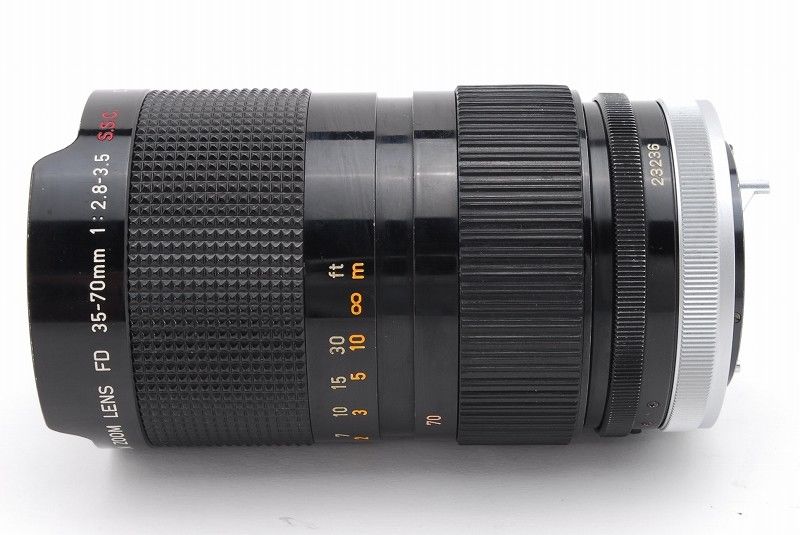
#2
 |
|
| Back to top |
|
 |
kievuser

Joined: 27 Jan 2008
Posts: 551
|
 Posted: Thu Nov 30, 2017 5:01 am Post subject: Posted: Thu Nov 30, 2017 5:01 am Post subject: |
 |
|
kievuser wrote:
| Oldhand wrote: |
Big, long, heavy and of limited focal range.
Yet one of the best FD zooms made by Canon and a bargain today.
Original Price 100,000 yen when released in 1973
Tom
#1

#2
 |
I will try to find one of this in good condition and good price. There are a few higher end zoom lenses in the 100.000 yen price range in the 1970's (about $500 USD). I could never afford them then.
Here is another Canon FD zoom lens 80-200/4 sold in the 100.000 yen price range. It is the non "L" version, but sold at about the same price.
Zhang
 |
|
| Back to top |
|
 |
cooltouch


Joined: 15 Jan 2009
Posts: 9096
Location: Houston, Texas
|
 Posted: Thu Nov 30, 2017 3:27 pm Post subject: Posted: Thu Nov 30, 2017 3:27 pm Post subject: |
 |
|
cooltouch wrote:
Regarding those two Canon zooms above, the 35-70/2.8-3.5 SSC was Canon's first wide-to-tele zoom, and I believe was the first ever wide to tele zoom. Canon was bound and determined that this zoom would be equal or superior to primes in the focal lengths it encompassed. This is one reason why it's as big as it is, and also why it was so expensive when new. Back in the day, street prices for that optic were in the $700-800 price range. That was a lot of money back in the 70s.
The 80-200 f/4 was Canon's first pro-quality FD telephoto zoom. Back in 1982, when I first got into photography in a serious way, I recall looking through the backs of the photo magazines at all the discount ads. I was surprised to find that the 80-200 sold for a LOT more than the newer push-pull 70-210/4. Once again, it was a historical thing. The 80-200 sold for more because it has always been an expensive zoom. Fortunately, these days, you can pick up, off eBay for example, clean copies of this lens for ridiculously low amounts. I own a 70-210 that came to me as part of a large FD outfit, but I plan on adding an 80-200/4 to my outfit as well, just for reasons of historic completeness. It will be interesting to do a comparison between the two and see how much better (if at all) the 80-200 is than the 70-210.
_________________
Michael
My Gear List: http://michaelmcbroom.com/photo/gear.html
My Gallery: http://michaelmcbroom.com/gallery3/index.php/
My Flickr Page: https://www.flickr.com/photos/11308754@N08/albums
My Music: https://soundcloud.com/michaelmcbroom/albums
My Blog: http://michaelmcbroom.com/blogistan/ |
|
| Back to top |
|
 |
kds315*


Joined: 12 Mar 2008
Posts: 16654
Location: Weinheim, Germany
Expire: 2021-03-09
|
 Posted: Thu Nov 30, 2017 4:31 pm Post subject: Posted: Thu Nov 30, 2017 4:31 pm Post subject: |
 |
|
kds315* wrote:
| cooltouch wrote: |
Regarding those two Canon zooms above, the 35-70/2.8-3.5 SSC was Canon's first wide-to-tele zoom, and I believe was the first ever wide to tele zoom. Canon was bound and determined that this zoom would be equal or superior to primes in the focal lengths it encompassed. This is one reason why it's as big as it is, and also why it was so expensive when new. Back in the day, street prices for that optic were in the $700-800 price range. That was a lot of money back in the 70s.
The 80-200 f/4 was Canon's first pro-quality FD telephoto zoom. Back in 1982, when I first got into photography in a serious way, I recall looking through the backs of the photo magazines at all the discount ads. I was surprised to find that the 80-200 sold for a LOT more than the newer push-pull 70-210/4. Once again, it was a historical thing. The 80-200 sold for more because it has always been an expensive zoom. Fortunately, these days, you can pick up, off eBay for example, clean copies of this lens for ridiculously low amounts. I own a 70-210 that came to me as part of a large FD outfit, but I plan on adding an 80-200/4 to my outfit as well, just for reasons of historic completeness. It will be interesting to do a comparison between the two and see how much better (if at all) the 80-200 is than the 70-210. |
Would you consider these very early ones to deliver up to today's standards? Of course nice collector pieces they are..
_________________
Klaus - Admin
"S'il vient a point, me souviendra" [Thomas Bohier (1460-1523)]
http://www.macrolenses.de for macro and special lens info
http://www.pbase.com/kds315/uv_photos for UV Images and lens/filter info
https://www.flickr.com/photos/kds315/albums my albums using various lenses
http://photographyoftheinvisibleworld.blogspot.com/ my UV BLOG
http://www.travelmeetsfood.com/blog Food + Travel BLOG
https://galeriafotografia.com Architecture + Drone photography
Currently most FAV lens(es):
X80QF f3.2/80mm
Hypergon f11/26mm
ELCAN UV f5.6/52mm
Zeiss UV-Planar f4/60mm
Zeiss UV-Planar f2/62mm
Lomo Уфар-12 f2.5/41mm
Lomo Зуфар-2 f4.0/350mm
Lomo ZIKAR-1A f1.2/100mm
Nikon UV Nikkor f4.5/105mm
Zeiss UV-Sonnar f4.3/105mm
CERCO UV-VIS-NIR f1.8/45mm
CERCO UV-VIS-NIR f4.1/94mm
CERCO UV-VIS-NIR f2.8/100mm
Steinheil Quarzobjektiv f1.8/50mm
Pentax Quartz Takumar f3.5/85mm
Carl Zeiss Jena UV-Objektiv f4/60mm
NYE OPTICAL Lyman-Alpha II f1.1/90mm
NYE OPTICAL Lyman-Alpha I f2.8/200mm
COASTAL OPTICS f4/60mm UV-VIS-IR Apo
COASTAL OPTICS f4.5/105mm UV-Micro-Apo
Pentax Ultra-Achromatic Takumar f4.5/85mm
Pentax Ultra-Achromatic Takumar f5.6/300mm
Rodenstock UV-Rodagon f5.6/60mm + 105mm + 150mm
|
|
| Back to top |
|
 |
stevemark

Joined: 29 Apr 2011
Posts: 4018
Location: Switzerland
|
 Posted: Thu Nov 30, 2017 6:17 pm Post subject: Posted: Thu Nov 30, 2017 6:17 pm Post subject: |
 |
|
stevemark wrote:
| cooltouch wrote: |
| Regarding those two Canon zooms above, the 35-70/2.8-3.5 SSC was Canon's first wide-to-tele zoom, |
Yes, and - more important - it was the first two-group-zoom to be sold.
| cooltouch wrote: |
| and I believe was the first ever wide to tele zoom. |
Not quite. The Voigtländer 2.8/35-80 (around 1959) was already a wideangle, and a fast one, but performance was poor.
And Nikon had patented a huge 2.8-4/35-80mm some ten years before.
| cooltouch wrote: |
Canon was bound and determined that this zoom would be equal or superior to primes in the focal lengths it encompassed. This is one
reason why it's as big as it is, and also why it was so expensive when new. Back in the day, street prices for that optic were in the
$700-800 price range. That was a lot of money back in the 70s. |
Absolutely right.
Before, most zooms (with exception of the Nikkor 2.8-4/35-80mm and the Nikkor 43-86mm) had been four-group zooms:
1) the master lens (e. g. a tessar-type lens) and
2) the focusing group (usually in front),
3) the zoom group in between them,
4) and a fourth compensator group to compensate for the focus shift introduced by the moving zoom group.
At that time, manufacturing an objective with 12-15 lenses was the maximum; more lenses would introduce too much ghosting /
reflexes / flare, and cause increasing mechanical troubles (quality control). Thus, one had usually 2-4 lenses per group, limiting the
possibilities for correction of each of the four groups.
Because of the room needed for the SLR mirror, the master group could not be mad as a wideangle. Therefore the entire zoom
would start at 50mm (or sometimes at 45mm), at best.
When Canon introduced the 2.8-3.5/35-70mm they had found a way to solve two major problems simultaneously. By constructing the
entire zoom similar to a ordinary retrofocus prime (consisting of a positive master lens plus negative wide angle
converter/zoom group in front), they could overcome the wideangle difficulties of four-group zooms. Zooming and focusing was
done by a complicated movement of the two groups. In addition - and that's why these zooms are so good - it was possible to use
more lenses (usually five) per group, without reaching the aforementioned limit of 12 or even 15 lenses for the entire zoom.
Even more rewarding, the Canon FD 2.8-3.5/35-70mm could be focused directly down to about 0.3m. No complicated macro
modes or buttons, no lens attachments needed ...
This concept was extremely successful. All later 3.5/35-70mm MF lenses were basically copies of the Canon 2.8-3.5/35-70mm (look at
the lens sections eg. of the 3.5/35-70mm Ai/AiS Nikkors, the Konica AR 3.5/35-70mm, the Zeiss C/Y 3.4/35-70mm, the Yashica ML
3.5/35-70mm, the Olympus OM 3.5/35-70mm and many others).
| cooltouch wrote: |
The 80-200 f/4 was Canon's first pro-quality FD telephoto zoom. Back in 1982, when I first got into photography in a serious way, I
recall looking through the backs of the photo magazines at all the discount ads. I was surprised to find that the 80-200 sold for a LOT
more than the newer push-pull 70-210/4. Once again, it was a historical thing. The 80-200 sold for more because it has always been an
expensive zoom. Fortunately, these days, you can pick up, off eBay for example, clean copies of this lens for ridiculously low amounts.
I own a 70-210 that came to me as part of a large FD outfit, but I plan on adding an 80-200/4 to my outfit as well, just for reasons of
historic completeness. It will be interesting to do a comparison between the two and see how much better (if at all) the 80-200 is than the 70-210. |
The 70-210mm is another interesting story. Many manufacturers previoulsy hat 4.5/80-200mm zooms with 14-16 lenses, but around
1983 the major companies started manufacturing 4/70-210mm zooms with only 12 lenses. Nevertheless these 70-210mm were as
good or even better than the previous much more complicated tele zooms. The lens section of these 4/70-210mm zooms is so similar
that i suspect a certain degree of collaboration between the manufacturers. It is known that Leica has been the driving force behind the
transition from Minoltas MD 4.5/75-200mm to the later (and better) MD 4/70-210mm (Leica sold the same design in a different housing
for their R system). Ten years later this design was improved again by Lothar Kölsch at Zeiss (Zeiss CY 4/80-200mm); and not much
later this Zeiss design would be boosted again, to become the Leica R APO 2.8/70-180mm.
| kds315* wrote: |
| Would you consider these very early ones to deliver up to today's standards? Of course nice collector pieces they are.. |
I have been testing about twelve different MF 35-70mm lenses side by side, among them the Canon FD 2.8-3.5/35-70mm and the
AiS Nikkor 3.5/35-70mm. The Canon is exceptionally sharp at 2.8/35mm, but must be stopped down to f5.6 or f8 at 70mm:
http://www.artaphot.ch/systemuebergreifend/objektive/451-35-70mm-zooms
The (later) AiS Nikkor 3.5/35-70mm [62mm filter] is even better at f=70mm, and it has very little distortion (<1% over the entire
range). No other 35-70mm has so little distortion; even the Zeiss is in the 2-3% range, which is clearly visible.
The 2nd Nikkor 3.5/35-70mm (the AiS version with 62mm filter thread) is perfectly useable on 24MP FF, even wide open.
I usually work with a 2.8/16-35mm and a 2.8/70-200mm zoom, thus omiting the "normal zoom". If i need something in the 35-70mm range i take the Nikkor. In the 50-100mm range i prefer the Minolta AF 28-135mm which is much better than other similar zooms, and at f=70mm even much better than the Zeiss 2.8/24-70mm, the Sony/Minolta 2.8/70-200mm G or the Minolta 28-70mm G:
http://www.artaphot.ch/minolta-sony-af/objektiv-vergleiche/311-70mm-pisa-2008
Later fast AF zoom such as the AF Nikkor 2.8/35-70mm (a four group zoom !!) or the Sony Zeiss ZA 2.8/24-70mm and ZA
2.8/16-35mm and have much worse corners, at 35mm anf f2.8. The last generation of Canons EF 2.8/16-35mm (the "III") does not have these problems.
Stephan
_________________
www.artaphot.ch |
|
| Back to top |
|
 |
Oldhand


Joined: 01 Apr 2013
Posts: 6005
Location: Mid North Coast NSW - Australia
|
 Posted: Thu Nov 30, 2017 8:03 pm Post subject: Posted: Thu Nov 30, 2017 8:03 pm Post subject: |
 |
|
Oldhand wrote:
Thank you Stephan and Michael for the very useful background information.
Here are a couple more images of my Canon 
Tom
#1
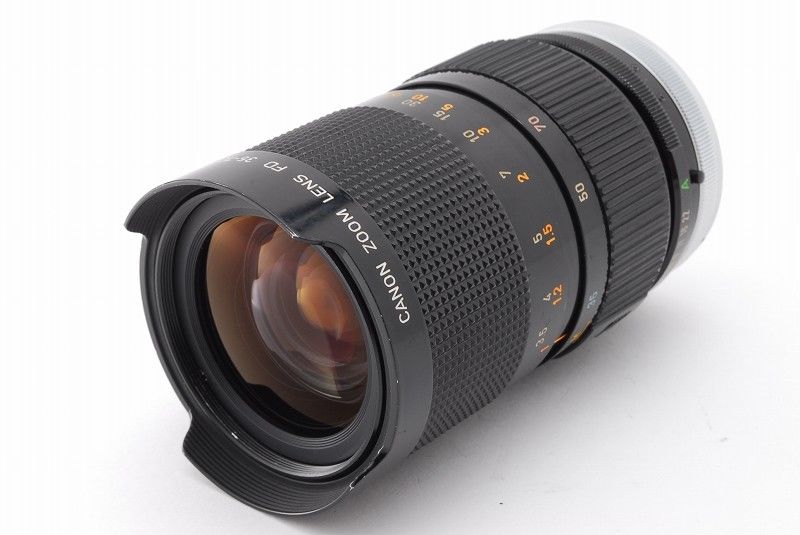
#2
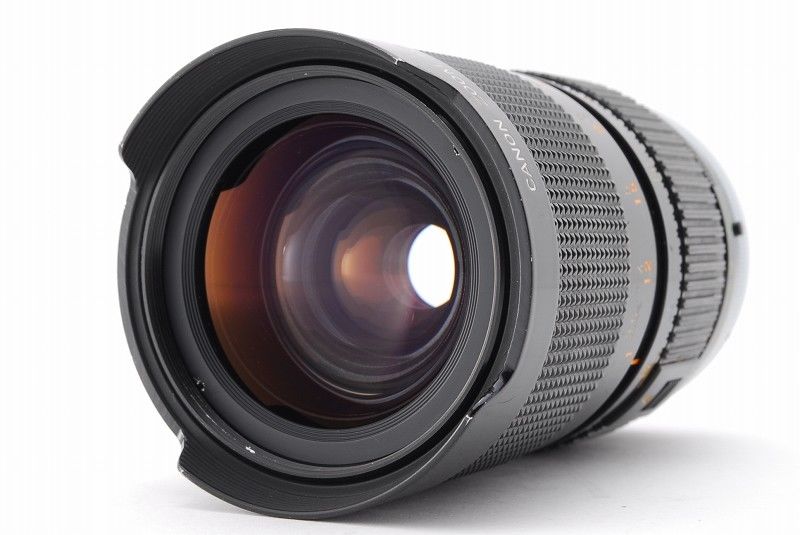 |
|
| Back to top |
|
 |
kievuser

Joined: 27 Jan 2008
Posts: 551
|
 Posted: Fri Dec 01, 2017 5:57 am Post subject: Posted: Fri Dec 01, 2017 5:57 am Post subject: |
 |
|
kievuser wrote:
| Oldhand wrote: |
Thank you Stephan and Michael for the very useful background information.
Here are a couple more images of my Canon 
Tom
#1

#2
 |
May I say the same? 
Canon FD mount lenses were unwanted a few years ago for the difficult to use them on other mount cameras. Now with Sony A7 series cameras, they find their new life. |
|
| Back to top |
|
 |
kds315*


Joined: 12 Mar 2008
Posts: 16654
Location: Weinheim, Germany
Expire: 2021-03-09
|
 Posted: Fri Dec 01, 2017 7:05 am Post subject: Posted: Fri Dec 01, 2017 7:05 am Post subject: |
 |
|
kds315* wrote:
Thanks to all for the excellent contributions on early Canon zoom lenses!
To provent it from getting, I decided to extract that and make it into a seperate thread here!
_________________
Klaus - Admin
"S'il vient a point, me souviendra" [Thomas Bohier (1460-1523)]
http://www.macrolenses.de for macro and special lens info
http://www.pbase.com/kds315/uv_photos for UV Images and lens/filter info
https://www.flickr.com/photos/kds315/albums my albums using various lenses
http://photographyoftheinvisibleworld.blogspot.com/ my UV BLOG
http://www.travelmeetsfood.com/blog Food + Travel BLOG
https://galeriafotografia.com Architecture + Drone photography
Currently most FAV lens(es):
X80QF f3.2/80mm
Hypergon f11/26mm
ELCAN UV f5.6/52mm
Zeiss UV-Planar f4/60mm
Zeiss UV-Planar f2/62mm
Lomo Уфар-12 f2.5/41mm
Lomo Зуфар-2 f4.0/350mm
Lomo ZIKAR-1A f1.2/100mm
Nikon UV Nikkor f4.5/105mm
Zeiss UV-Sonnar f4.3/105mm
CERCO UV-VIS-NIR f1.8/45mm
CERCO UV-VIS-NIR f4.1/94mm
CERCO UV-VIS-NIR f2.8/100mm
Steinheil Quarzobjektiv f1.8/50mm
Pentax Quartz Takumar f3.5/85mm
Carl Zeiss Jena UV-Objektiv f4/60mm
NYE OPTICAL Lyman-Alpha II f1.1/90mm
NYE OPTICAL Lyman-Alpha I f2.8/200mm
COASTAL OPTICS f4/60mm UV-VIS-IR Apo
COASTAL OPTICS f4.5/105mm UV-Micro-Apo
Pentax Ultra-Achromatic Takumar f4.5/85mm
Pentax Ultra-Achromatic Takumar f5.6/300mm
Rodenstock UV-Rodagon f5.6/60mm + 105mm + 150mm
|
|
| Back to top |
|
 |
kievuser

Joined: 27 Jan 2008
Posts: 551
|
 Posted: Fri Dec 01, 2017 11:44 am Post subject: Posted: Fri Dec 01, 2017 11:44 am Post subject: |
 |
|
kievuser wrote:
| kds315* wrote: |
Thanks to all for the excellent contributions on early Canon zoom lenses!
To provent it from getting, I decided to extract that and make it into a seperate thread here! |
Thanks for reorganizing the posts together. Here is a chart I saw on a Chinese site. It is handy to find information about those Canon FD zoom lenses:
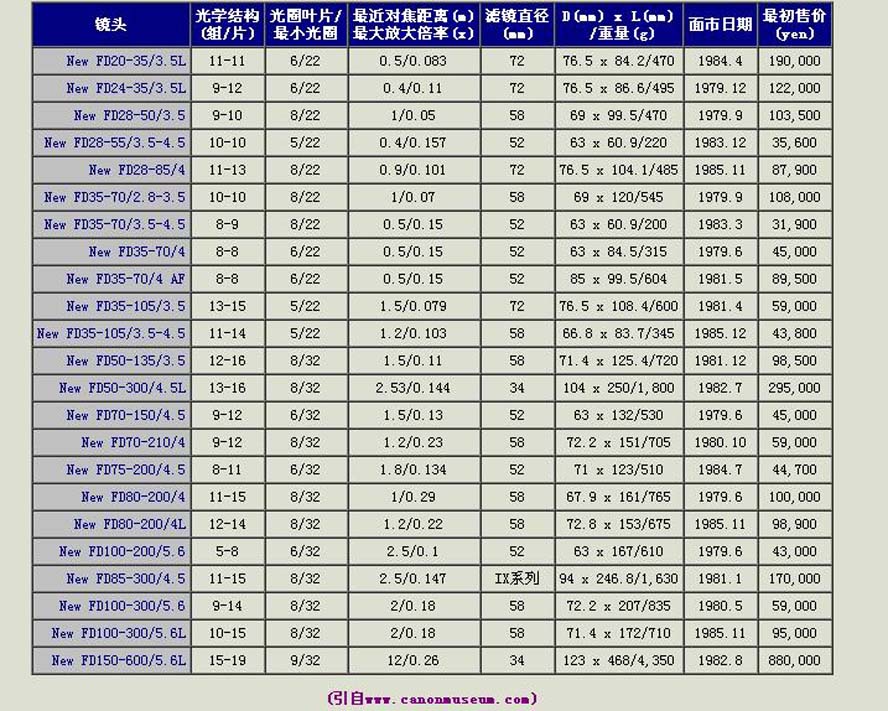 |
|
| Back to top |
|
 |
Lightshow


Joined: 04 Nov 2011
Posts: 3666
Location: Calgary
|
 Posted: Fri Dec 01, 2017 4:21 pm Post subject: Posted: Fri Dec 01, 2017 4:21 pm Post subject: |
 |
|
Lightshow wrote:
All we need now are some sample pictures for this thread.... 
_________________
A Manual Focus Junky...
One photographers junk lens is an artists favorite tool.
My lens list
http://www.flickr.com/photos/lightshow-photography/ |
|
| Back to top |
|
 |
cooltouch


Joined: 15 Jan 2009
Posts: 9096
Location: Houston, Texas
|
 Posted: Fri Dec 01, 2017 5:58 pm Post subject: Posted: Fri Dec 01, 2017 5:58 pm Post subject: |
 |
|
cooltouch wrote:
A very interesting price chart, and for New FD lenses even. One thing I was particularly surprised about -- recall my mentioning how expensive the original 80-200 f/4 two-ring zoom was? Look at its price compared to the price of the 80-200mm f/4 L. It actually sold for more than the 80-200/4 L! A lens widely regarded as Canon's best short-to-medium tele. And the 35-70/2.8-3.5 actually sold for more than either of the 80-200s. Amazing.
_________________
Michael
My Gear List: http://michaelmcbroom.com/photo/gear.html
My Gallery: http://michaelmcbroom.com/gallery3/index.php/
My Flickr Page: https://www.flickr.com/photos/11308754@N08/albums
My Music: https://soundcloud.com/michaelmcbroom/albums
My Blog: http://michaelmcbroom.com/blogistan/ |
|
| Back to top |
|
 |
stevemark

Joined: 29 Apr 2011
Posts: 4018
Location: Switzerland
|
 Posted: Fri Dec 01, 2017 11:47 pm Post subject: Posted: Fri Dec 01, 2017 11:47 pm Post subject: |
 |
|
stevemark wrote:
There's another quite expensive zoom in the above list, the nFD 3.5/50-135mm. It came to the market quite late (1981, three years after the Minolta MD 3.5/50-135mm), and it took me quite some time to get one. The nFD has a complicated design (16 lenses!), and performs - according to my preliminary tests - quite well, probably better than the Minolta.
One of the best non-L nFD zooms (probably even the best) is the nFD 4.5/70-150mm. Nearly no CAs, sharp corners wide open (24MP FF), and a built-in hood: an excellent lens e. g. for hiking. To be fair: the corresponding Minolta MD 4/75-150mm is lighter, faster, and as good as the Canon. But still, the Canon 4.5/70-150mm is one of the few really good vintage MF zooms ...
Stephan
_________________
www.artaphot.ch |
|
| Back to top |
|
 |
cooltouch


Joined: 15 Jan 2009
Posts: 9096
Location: Houston, Texas
|
 Posted: Sat Dec 02, 2017 5:45 am Post subject: Posted: Sat Dec 02, 2017 5:45 am Post subject: |
 |
|
cooltouch wrote:
Good to know. I've never used either of the zooms you mention. Mostly I guess because I've always considered their zoom range to be rather oddball. Having a constant aperture makes them more desirable, I suppose. And it seems that both would probably work well as portrait lenses. The one FD lens I own that is sort of in the ball park of these two is the 35-105/3.5. A very nice optic with its constant f/3.5 aperture, and one of my favorite nFD lenses.
_________________
Michael
My Gear List: http://michaelmcbroom.com/photo/gear.html
My Gallery: http://michaelmcbroom.com/gallery3/index.php/
My Flickr Page: https://www.flickr.com/photos/11308754@N08/albums
My Music: https://soundcloud.com/michaelmcbroom/albums
My Blog: http://michaelmcbroom.com/blogistan/ |
|
| Back to top |
|
 |
kievuser

Joined: 27 Jan 2008
Posts: 551
|
 Posted: Sat Dec 02, 2017 12:33 pm Post subject: Posted: Sat Dec 02, 2017 12:33 pm Post subject: |
 |
|
kievuser wrote:
One lens to note is the New FD20-35mm F3.5L. It has an original price higher than that of Nikon 58mm F1.2 Noct.!(190,000 vs 150,000 yen) Yet it sells for peanuts on ebay these days. |
|
| Back to top |
|
 |
cooltouch


Joined: 15 Jan 2009
Posts: 9096
Location: Houston, Texas
|
 Posted: Sat Dec 02, 2017 1:15 pm Post subject: Posted: Sat Dec 02, 2017 1:15 pm Post subject: |
 |
|
cooltouch wrote:
Your definition of "peanuts" must be a lot different from mine. On US eBay, the 20-35 L is selling in the $400 range. To me, that's a lot to pay for a lens. However, I suppose if I were to consider the primes it replaces: 20mm, 24mm, 28mm, and 35mm, then it looks as if it might be a better deal. But then I add up typical prices on eBay for each of these focal lengths in Canon FD flavor. Not Vivitar or Tamron or some other aftermarket maker, but Canon FD, whether SSC or new FD. And I'm coming up with about $430 or thereabouts. So even when you compare the 20-35L against Canon primes, any price benefit is fairly marginal.
But it's an "L" lens, one might say. My response is the regular primes, even at f/2.8, are very well corrected, and the 20-35 zoom probably needs the L glass because it's a zoom.
Still -- I sure wouldn't mind having one. 
_________________
Michael
My Gear List: http://michaelmcbroom.com/photo/gear.html
My Gallery: http://michaelmcbroom.com/gallery3/index.php/
My Flickr Page: https://www.flickr.com/photos/11308754@N08/albums
My Music: https://soundcloud.com/michaelmcbroom/albums
My Blog: http://michaelmcbroom.com/blogistan/ |
|
| Back to top |
|
 |
Sciolist


Joined: 29 Mar 2017
Posts: 1445
Location: Scotland
Expire: 2021-04-16
|
 Posted: Sat Dec 02, 2017 1:24 pm Post subject: Posted: Sat Dec 02, 2017 1:24 pm Post subject: |
 |
|
Sciolist wrote:
| Oldhand wrote: |
Big, long, heavy and of limited focal range.
|
But they zoomed Oldhand, they zoomed. A no brainer.  |
|
| Back to top |
|
 |
Lloydy


Joined: 02 Sep 2009
Posts: 7794
Location: Ironbridge. UK.
Expire: 2022-01-01
|
 Posted: Sat Dec 02, 2017 1:36 pm Post subject: Posted: Sat Dec 02, 2017 1:36 pm Post subject: |
 |
|
Lloydy wrote:
I had the 80-200 f4 for a long time and it was a very good lens from what I remember. In the mid 1970's I bought a complete Canon kit from my friend who was working in Saudia and earning big wages, he bought the A1 and a set of fast lenses, motor drive the whole lot in Hong Kong, used the kit for year and lost interest, I bought it cheap to be honest. And wish I'd still got it all.
_________________
LENSES & CAMERAS FOR SALE.....
I have loads of stuff that I have to get rid of, if you see me commenting about something I have got and you want one, ask me.
My Flickr https://www.flickr.com/photos/mudplugga/
My ipernity -
http://www.ipernity.com/home/294337 |
|
| Back to top |
|
 |
cooltouch


Joined: 15 Jan 2009
Posts: 9096
Location: Houston, Texas
|
 Posted: Sat Dec 02, 2017 1:49 pm Post subject: Posted: Sat Dec 02, 2017 1:49 pm Post subject: |
 |
|
cooltouch wrote:
So, Lloydy, from what you recall, would you say the 80-200/4 you had compares favorably to modern zooms in that same focal range and aperture? Without trying one (yet), my gut says yes.
_________________
Michael
My Gear List: http://michaelmcbroom.com/photo/gear.html
My Gallery: http://michaelmcbroom.com/gallery3/index.php/
My Flickr Page: https://www.flickr.com/photos/11308754@N08/albums
My Music: https://soundcloud.com/michaelmcbroom/albums
My Blog: http://michaelmcbroom.com/blogistan/ |
|
| Back to top |
|
 |
Lloydy


Joined: 02 Sep 2009
Posts: 7794
Location: Ironbridge. UK.
Expire: 2022-01-01
|
 Posted: Sat Dec 02, 2017 3:09 pm Post subject: Posted: Sat Dec 02, 2017 3:09 pm Post subject: |
 |
|
Lloydy wrote:
| cooltouch wrote: |
| So, Lloydy, from what you recall, would you say the 80-200/4 you had compares favorably to modern zooms in that same focal range and aperture? Without trying one (yet), my gut says yes. |
Its a long time since I used it, but I have good memories of it. Back then my parents were living more or less on the end of the runway at Cosford RAF where one of the best UK air shows has been held for many years, so we would sit on our side of the fence and enjoy the show, and I got some good shots with that 80-200, and the 500 / 8 mirror lens. And I took a lot of rallying pictures as well.
It also got a lot of use when we traveled in Canada and the USA when I would shoot slide, Ektachome or Fujichrome, with the A1 and AE1P. I liked the zoom when traveling and bought a Ritzcam 28-85 / 3.5 4.5 from a shop in L.A. to compliment the 80-200, and what a disappointment that was when I got home and had my slides processed. The Ritzcam might have been acceptable, but not when compared to the Canon. I'm still annoyed with myself for trading that whole kit in against a EOS600 IN 1990 for £250, and it's that 80-200 that I miss the most because I believe it would hold it's own against modern zooms, probably better than many.
_________________
LENSES & CAMERAS FOR SALE.....
I have loads of stuff that I have to get rid of, if you see me commenting about something I have got and you want one, ask me.
My Flickr https://www.flickr.com/photos/mudplugga/
My ipernity -
http://www.ipernity.com/home/294337 |
|
| Back to top |
|
 |
Lloydy


Joined: 02 Sep 2009
Posts: 7794
Location: Ironbridge. UK.
Expire: 2022-01-01
|
 Posted: Sat Dec 02, 2017 3:16 pm Post subject: Posted: Sat Dec 02, 2017 3:16 pm Post subject: |
 |
|
Lloydy wrote:
Scanned from Canon Lens Work.
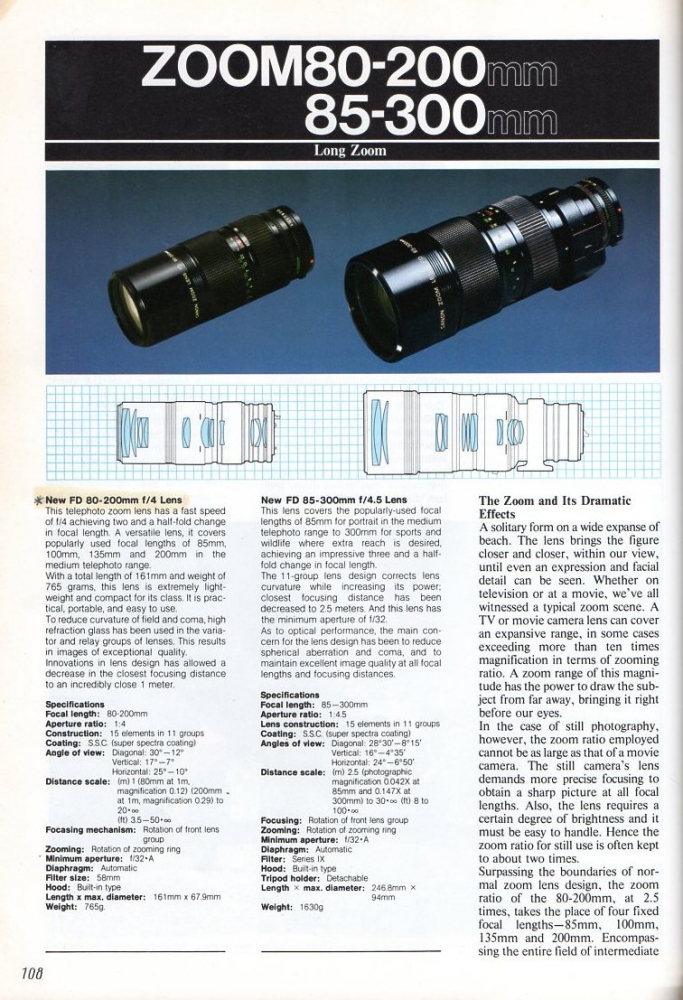
_________________
LENSES & CAMERAS FOR SALE.....
I have loads of stuff that I have to get rid of, if you see me commenting about something I have got and you want one, ask me.
My Flickr https://www.flickr.com/photos/mudplugga/
My ipernity -
http://www.ipernity.com/home/294337 |
|
| Back to top |
|
 |
Lloydy


Joined: 02 Sep 2009
Posts: 7794
Location: Ironbridge. UK.
Expire: 2022-01-01
|
 Posted: Sat Dec 02, 2017 3:23 pm Post subject: Posted: Sat Dec 02, 2017 3:23 pm Post subject: |
 |
|
Lloydy wrote:
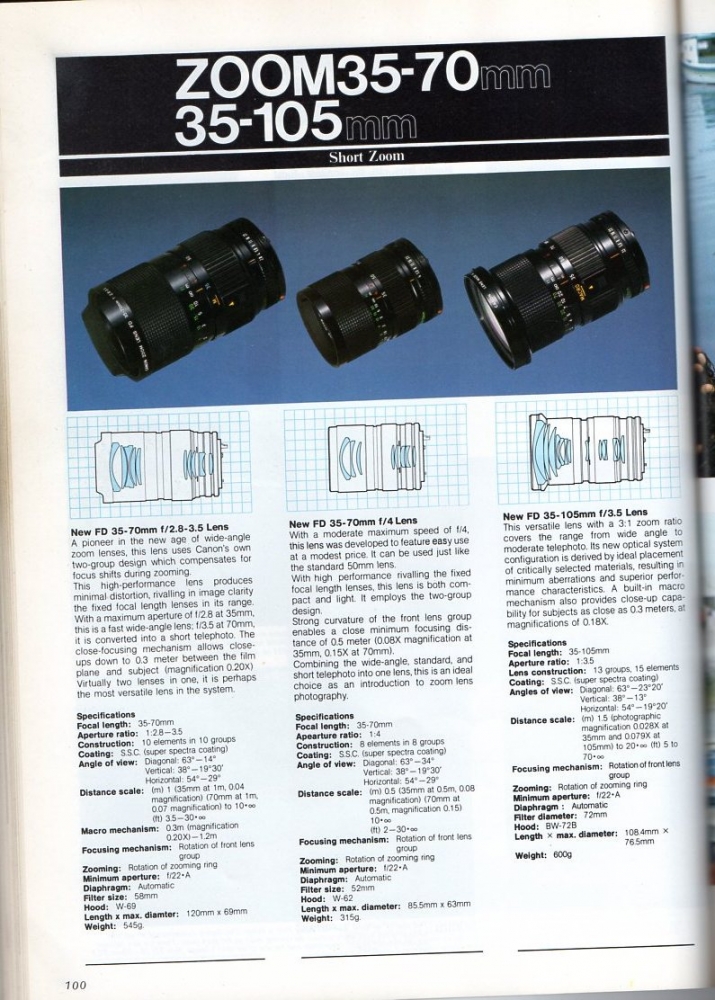
_________________
LENSES & CAMERAS FOR SALE.....
I have loads of stuff that I have to get rid of, if you see me commenting about something I have got and you want one, ask me.
My Flickr https://www.flickr.com/photos/mudplugga/
My ipernity -
http://www.ipernity.com/home/294337 |
|
| Back to top |
|
 |
cooltouch


Joined: 15 Jan 2009
Posts: 9096
Location: Houston, Texas
|
 Posted: Sat Dec 02, 2017 4:19 pm Post subject: Posted: Sat Dec 02, 2017 4:19 pm Post subject: |
 |
|
cooltouch wrote:
| Lloydy wrote: |
| I'm still annoyed with myself for trading that whole kit in against a EOS600 IN 1990 for £250, and it's that 80-200 that I miss the most because I believe it would hold it's own against modern zooms, probably better than many. |
I don't know how it is with UK eBay, but over on this side of the pond, you can pick up clean examples of the 80-200/4 for really cheap prices. Considering how much that lens sold for new, the prices it is selling for on US eBay are virtually a steal.
Update: Well I just put my money where my mouth is, er--my fingers are. I just bought this:
Click here to see on Ebay
_________________
Michael
My Gear List: http://michaelmcbroom.com/photo/gear.html
My Gallery: http://michaelmcbroom.com/gallery3/index.php/
My Flickr Page: https://www.flickr.com/photos/11308754@N08/albums
My Music: https://soundcloud.com/michaelmcbroom/albums
My Blog: http://michaelmcbroom.com/blogistan/ |
|
| Back to top |
|
 |
kievuser

Joined: 27 Jan 2008
Posts: 551
|
 Posted: Sun Dec 03, 2017 4:38 am Post subject: Posted: Sun Dec 03, 2017 4:38 am Post subject: |
 |
|
kievuser wrote:
| cooltouch wrote: |
Your definition of "peanuts" must be a lot different from mine. On US eBay, the 20-35 L is selling in the $400 range. To me, that's a lot to pay for a lens. However, I suppose if I were to consider the primes it replaces: 20mm, 24mm, 28mm, and 35mm, then it looks as if it might be a better deal. But then I add up typical prices on eBay for each of these focal lengths in Canon FD flavor. Not Vivitar or Tamron or some other aftermarket maker, but Canon FD, whether SSC or new FD. And I'm coming up with about $430 or thereabouts. So even when you compare the 20-35L against Canon primes, any price benefit is fairly marginal.
But it's an "L" lens, one might say. My response is the regular primes, even at f/2.8, are very well corrected, and the 20-35 zoom probably needs the L glass because it's a zoom.
Still -- I sure wouldn't mind having one.  |
It must be something wrong for my memory as I thought I saw one yesterday for something like $60-70 USD from a Japanese seller. But Today, it disappeared!? Perhaps it was a FD 35-70/2.8-3.5 that sells at the price range? Yes, a few of this lens listed for about $400 right now. |
|
| Back to top |
|
 |
Mr G

Joined: 27 Jan 2014
Posts: 187
Location: London & Essex
|
 Posted: Mon Dec 04, 2017 3:44 pm Post subject: Posted: Mon Dec 04, 2017 3:44 pm Post subject: |
 |
|
Mr G wrote:
| stevemark wrote: |
There's another quite expensive zoom in the above list, the nFD 3.5/50-135mm. It came to the market quite late (1981, three years after the Minolta MD 3.5/50-135mm), and it took me quite some time to get one. The nFD has a complicated design (16 lenses!), and performs - according to my preliminary tests - quite well, probably better than the Minolta.
One of the best non-L nFD zooms (probably even the best) is the nFD 4.5/70-150mm. Nearly no CAs, sharp corners wide open (24MP FF), and a built-in hood: an excellent lens e. g. for hiking. To be fair: the corresponding Minolta MD 4/75-150mm is lighter, faster, and as good as the Canon. But still, the Canon 4.5/70-150mm is one of the few really good vintage MF zooms ...
Stephan |
Hi guys interesting thread, I have the 50-135mm and liked it so much I had it converted to EF, it's a great lens, used it more on my old crop sensor as it essentially became an 80-200mm, I also have the 20-35mm L converted to EF and that's awesome.
There are probably sharper, lighter more compact modern optics around, but the build quality and feel and maybe even the nostalgic aspect speak to me.
Don't mistake me for a sentimentalist, I loved my first car, which was a Marina 1.8 TC Coupe but I wouldn't drive around in it now!
_________________
EVEN A BLIND SQUIRREL FINDS A NUT NOW AND THEN! |
|
| Back to top |
|
 |
stevemark

Joined: 29 Apr 2011
Posts: 4018
Location: Switzerland
|
 Posted: Tue Dec 05, 2017 5:07 pm Post subject: Posted: Tue Dec 05, 2017 5:07 pm Post subject: |
 |
|
stevemark wrote:
| cooltouch wrote: |
Good to know. I've never used either of the zooms you mention.
...
The one FD lens I own that is sort of in the ball park of these two is the 35-105/3.5. A very nice optic with its constant f/3.5 aperture, and one of my favorite nFD lenses. |
The nFD 3.5/35-105mm (not to confuse with the later aspherical nFD 3.5-4.5/35-105mm) doesn't reach the levels of the nFD 75-150mm or the nFD 50-135mm. Corners are pretty blurry on 24MP FF, as far as i remember. The Minolta MD 3.5-4.5/35-105mm (II) or the Minolta AF 3.5-4.5/35-105mm (first, all-metal "beercan" generation!) are a lot better.
Stephan
_________________
www.artaphot.ch |
|
| Back to top |
|
 |
|
|
